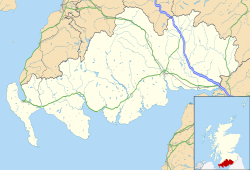History
The first municipal structure in Stanraer was a tolbooth which was built on part of the local parish churchyard and dated back to the late 17th century: the tolbooth was the host to an Irish pirate known as "Mccairty" who was captured off the coast of Kirkcudbrightshire and imprisoned there in 1699. [2] By the 1770s, the tolbooth was very dilapidated and the burgh leaders decided to demolish it and replace it with a new town hall on the same site. [3]
The new building was designed and built by Edward Wallace and Thomas Hall in the neoclassical style, built in rubble masonry with a stucco finish and was completed in June 1776. [4] The design involved a symmetrical main frontage with three bays facing onto George Street; the central bay, which slightly projected forward, featured a doorway with a fanlight and a pediment above; on the first floor there was a panel showing the burgh coat of arms which depicted a ship with three sails and the motto "Tutissima Statio" (English: "The safest station"). The outer bays were fenestrated with sash windows on the first floor, while the central bay was surmounted by a tower, with a parapet and a balustrade in the first stage, an octagonal belfry in the second stage and a spire with a weather vane above. [1] Internally, the principal rooms were the guardhouse and the lock-up on the ground floor and the debtors' prison, which was later converted for use as a council chamber, on the first floor. [4] The building was extended to the rear to accommodate a corn exchange and a courtroom in 1855. [3]
After the council relocated to new premises in Lewis Street in 1874, the old town hall was briefly used as a drill hall and armoury for the 2nd Wigtownshire Rifle Volunteer Corps, [5] and was then used as the home of the Athenaeum Club, before being taken over by the fire service in 1879. [6] A clock, which was presented to the town by a former town clerk, William Black, was installed in the tower in 1936. [3] The fire service eventually relocated from the town hall to a new purpose-built fire station in Lewis Street in 1960. [7] The Stranraer Museum, which by the middle of the 20th century had built up a substantial collection of axes and other archaeological exhibits, then established itself in the building. [8] Other significant items which were added to the collection included an 18th century plough, [9] as well as a variety of items relating to the polar explorers, Sir John Ross, and his nephew, James Clark Ross. [10]
Works of art in the building include a painting by Henry John Dobson depicting an old lady spinning, [11] and a painting by George Pirie depicting a boy with a terrier and pups, [12] as well as landscape paintings by Alexander Brownlie Docharty, [13] George Houston [14] and Archibald David Reid. [15]
This page is based on this
Wikipedia article Text is available under the
CC BY-SA 4.0 license; additional terms may apply.
Images, videos and audio are available under their respective licenses.

